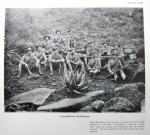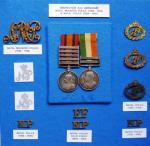-
Posts
858 -
Joined
-
Last visited
-
Days Won
6
Content Type
Profiles
Forums
Blogs
Gallery
Events
Store
Everything posted by Brett Hendey
-

RARE ZULU WAR MEDAL - 1879
Brett Hendey replied to Mervyn Mitton's topic in Great Britain: Orders, Gallantry, Campaign Medals
Mervyn Stretch's medal is 'missing'. I have been looking out for it ever since I started collecting medals, but there has been no sign it still exists. I was excited by your posting of Smith's medal because the BBG was such a small unit and the two men must have known each other well. Regards Brett -

RARE ZULU WAR MEDAL - 1879
Brett Hendey replied to Mervyn Mitton's topic in Great Britain: Orders, Gallantry, Campaign Medals
Mervyn A great medal! A brother of my paternal grandmother (Trooper Charles Lennox Stretch) served in the Buffalo Border Guard and was an Isandlwana survivor, so I have long been interested in this unit. Regards Brett -

Natal Guides
Brett Hendey replied to Stuart Bates's topic in Great Britain: Militaria: Badges, Uniforms & Equipment
The accompanying photograph is from a book on the Siege of Ladysmith. The caption reads: Major Henderson and scouts, who as guides, led the Gun Hill expedition on the night of December 8, when one "Long Tom" and one 4.7 gun were destroyed, and one Maxim captured. The long cleaning rod was that used by the Boer gunners. Major D Henderson was the Officer Commanding the Natal Guides during the Boer War. The group in this photograph was besieged in Ladysmith, but other Guides took part in the relief operations. Brett -

Zulu items
Brett Hendey replied to helen's topic in Great Britain: Militaria: Badges, Uniforms & Equipment
Mervyn Many thanks for your helpful reply. Regards Brett -

Zulu items
Brett Hendey replied to helen's topic in Great Britain: Militaria: Badges, Uniforms & Equipment
In another inappropriate thread, the matter of a Zulu battle-axe in my collection was mentioned. Mervyn expressed interest, so I am repeating relevant information here, together with photographs of the axe. The axe and a heap of other weapons were confiscated by police after a faction fight in the Tugela River valley in about 1950. I liberated the axe and an assegai from the pile of confiscated weapons. There were probably other souvenirs taken, but most of the weapons were subsequently destroyed. The axe head is no longer in its original handle and has been fixed to a stout stick 86 cm long. The second photograph shows the ingenious method used to hold the axe head tightly in position. The work was clearly done by a Zulu blacksmith 'in the field' and not in a sophisticated workshop. While this axe may not appeal to the purist collector, it does have the advantage of being an effective weapon that was carried, and perhaps used, in anger in a fight between two groups of Zulus. Such faction fights still occur, but the weapons used are likely to be modern automatic rifles. I was told that the once common AK47 is now less favoured because ammunition has become difficult to acquire. Instead, the weapons used by the South Africa Police and South African Defence Force are preferred, because both guns and ammunition are easier to come by. Brett -

Turkey Korean War Medal given to the Turkish Troops by UN
Brett Hendey replied to demir's topic in Türkiye
Demir The Q's and A's 3 and 4 contained information new to me and I found it interesting. Thank you for posting. Regards Brett -
Demir This is another very interesting and valuable record of the Turkish involvement in the Korean War. Thank you for the posting. Regards Brett
-
Demir Thank you for a great posting. Regards Brett
-
Marc I was very interested to read of your Sgt Locke project. You probably have all the information that I have to hand, but I will repeat it anyway: N Locke enlisted in the Natal Mounted Police on 24/3/1892. (The NMP became the Natal Police in 1894 when Natal became a self-governing Colony. Locke would therefore have worn both NMP and NP badges during his service.) The NMP/NP Enlistment Register (& other NMP/NP documents) are kept in the Pietermaritzburg Repository of the South African National Archives. Locke's entry is likely to give only his next-of-kin and address, which you probably have anyway. If you want a copy of the relevant page, please let me know. I will check for other mentions of Locke in the Pietermaritzburg files but, in general, records of individuals in the NMP/NP are poor. Holt's account of the Mahlabatini incident is copied virtually verbatim from Inspector (later Chief Commissioner) W J Clarke's record of the event, which was published in the NP magazine, 'The Nongqai'. (It seems to me that Holt shamelessly plagiarised Clarke's records of the NMP/NP to produce his book.) It may be worth having a copy of Clarke's account in order to check that Holt included all Clarke's details of the event. I can make a photocopy for you. I know someone who has been recording military graves in Natal and I will ask about that of Locke. Such graves are often neglected and sometimes vandalised and, since Locke's is in a remote part of Zululand, it may not be in good shape. Good luck with your project. Regards Brett
-

Three-Sovereign Groups
Brett Hendey replied to Ed_Haynes's topic in Great Britain: Orders, Gallantry, Campaign Medals
In my part of the world three-sovereign groups are common because of three conflicts in which many local men were involved: Anglo-Boer War (1899-1902) - Queen Victoria/King Edward VII Natal Rebellion (1906) - King Edward VII World War I, especially German South West Africa & German East Africa (1914-18) - King George V One such medal group is shown below. Brett -

BSAP uniform
Brett Hendey replied to Robert L.'s topic in Great Britain: Mervyn Mitton's British & Colonial Police Forces
Robert Congratulations! It looks to be a great addition to any collection of uniforms. Do you have details of Sanderson's service record? Regards Brett -
Kpl Johannes Jacobus Loggenberg is listed as having served with the General Beyers Commando in the ABO medal roll. According to another source, Gen Beyers began his service as an Assistant Field Cornet in the Boksburg Commando. After the fall of Pretoria he was promoted to Assistant Commandant-General of the Waterberg and Zoutpansberg Commandos and he spent the rest of the war fighting the British in the northern Transvaal. Brett PS I forgot to mention that Boksburg etc are in the Transvaal, so Loggenberg wore the medal with the Transvaal (ZAR) arms facing forward, i.e. the side with the lion top left and waggon below.
-
After a VERY long delay, the following book will be on sale from 15 July 2010: Official History of the South African Naval Forces during the Second World War (1939 - 1945) by Cdr H R Gordon-Cumming Published by The South African Naval Heritage Trust. The book costs SA Rand 250 (about 20 gbp) + R30 postage in South Africa (more overseas), and can be obtained from: The Naval Heritage Trust, P O Box 521, Simon's Town 7995. I suggest that people overseas who want to purchase this book contact RAdm Chris Bennett of the NHT (wiggyben@gmail.com) for postage costs and preferred method of payment. Brett
-
The horseman chasing the Boer is probably intended to represent an officer (clue: the sword) in the South African Light Horse (clue: the plume of long black feathers on the hat). The feathers came from the males of a small grassland bird, the long-tailed widow, which is known in Zulu as the "sakabula". Brett
-
Gordon Attached is a photograph of some of the Natal Mounted Police (1874 - 1894) and Natal Police (1894 - 1913) badges in my collection. Two that are missing are represented by photocopies. (The missing badges are recorded as collar badges but, in fact, were headgear badges.) I hope this helps you. Regards Brett
-
A friend, who is a collector of German militaria, has acquired the pair of unidentified shoulder straps shown below. The stamp on the underside may read "2nd Panzer Ersatz Div", or something similar. They are unlike any shoulder straps he has seen previously. Can anyone identify them? One possibility is that they are not German at all. The straps surfaced in South Africa and South African troops in World War II wore orange shoulder straps, although the only ones I have seen were made of felt. If they are indeed South African, perhaps a captured stamp was used to embellish an otherwise plain part of uniform. Any suggestions would be welcome. Brett
-
Emmanuel Thank you for posting the picture of the Videsh Siva with bar Korea - a rare and valuable medal. Regards Brett
-
Kevin Thanks for putting me right! Since my last post I have seen other reports on UN Korea Medals on the GMIC and elsewhere. Your book is still one of my favourites and I refer to it often. In the city where I live there is an informal 'medal club' that meets infrequently for 'show and tell' sessions and at the last meeting I took along your book and some of my Korean War medals and won a bottle of whiskey! You deserve a share of the bottle! I look forward to seeing the new edition of your book. Kind regards Brett
-
In his book on the medals of the Korean War, Kevin Ingraham records that there were 2 898 awards of the Croix de Guerre TOE during that war. Brett








